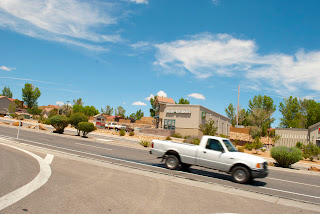 |
| The beauty of the forest survives the Las Conchas fire |
 |
| Parched landscape along Route 528 |
As we drive north and west of Albuquerque we skirt the usual array of bedroom communities that now surround many American cities.
 |
| Suburban sprawl along Route 528 west of Albuquerque |
Los Alamos, the bomb and a big fire
When we arrived in New Mexico several weeks ago the infamous Conchas wildfire had devastated northeastern Arizona. It had burned through the state border and headed toward Los Alamos. The city was evacuated but its residents had come back after the fire had been partially contained. Nonetheless, the absence of rain worried everyone in the area. As we drove in the direction of Los Alamos from Albuquerque, rain clouds began to gather for the third day in a row. This could be the day we have all hoped for.
 |
| Route 4 Valle Grande, Valles Caldera |
 |
| Still standing |
 |
| We can still find beauty among the ruins |
Los Alamos' chief claim to fame is that it was the birthplace of the atomic bomb, an achievement that is not universally applauded as something deserving of civic pride. The truth, of course, is that few if any, residents of the city actually participated in creating the bomb. The team headed by Robert Oppenheimer was comprised mostly of European scientists who were brought there by President Truman. Nonetheless, the city proudly displays a sign at the edge of town claiming that this is the place “ where discoveries are made”.
Awesome as the power of the atomic bomb may have been, we were much more impressed by the scenic beauty of the mountains that surround this city. This may qualify us as genuine tree huggers. So be it.
 |
| Rio Grande south of Los Alamos, New Mexico |

No comments:
Post a Comment